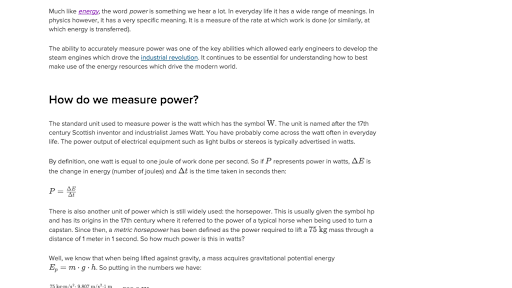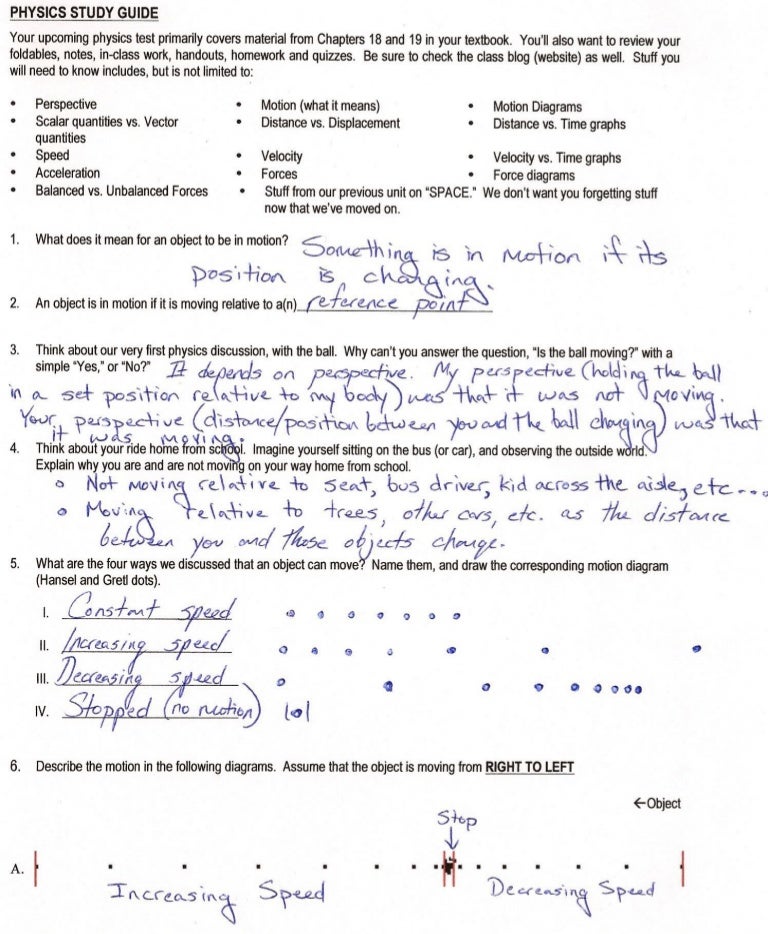3 Study Guide Describing Motion Answers Physics
1-D Kinematics - Lesson 2 - Describing Motion with Diagrams. In future studies, vector diagrams will be used to represent a variety of physical quantities such. Obtain Physics Study Guide Describing Motion Answers PDF Download as PDF of Physics Study Guide Describing Motion Answers Studying is a interest that can not be denied, because reading is add abducted about many things.
- Glencoe Physics Study Guide Answers
- Physics Study Guide Answers
- Physics Chapter 3 Describing Motion Study Guide Answers


. Identify and explain the properties of a projectile, such as acceleration due to gravity, range, maximum height, and trajectory. Determine the location and velocity of a projectile at different points in its trajectory. Apply the principle of independence of motion to solve projectile motion problems. Projectile motion is the motion of an object thrown or projected into the air, subject to only the acceleration of gravity. The object is called a projectile, and its path is called its trajectory.
The motion of falling objects, as covered in Problem-Solving Basics for One-Dimensional Kinematics, is a simple one-dimensional type of projectile motion in which there is no horizontal movement. In this section, we consider two-dimensional projectile motion, such as that of a football or other object for which air resistance is negligible.
The most important fact to remember here is that motions along perpendicular axes are independent and thus can be analyzed separately. This fact was discussed in, where vertical and horizontal motions were seen to be independent. The key to analyzing two-dimensional projectile motion is to break it into two motions, one along the horizontal axis and the other along the vertical. (This choice of axes is the most sensible, because acceleration due to gravity is vertical—thus, there will be no acceleration along the horizontal axis when air resistance is negligible.) As is customary, we call the horizontal axis the x-axis and the vertical axis the y-axis. Figure 1 illustrates the notation for displacement, where s is defined to be the total displacement and x and y are its components along the horizontal and vertical axes, respectively. The magnitudes of these vectors are s, x, and y. (Note that in the last section we used the notation A to represent a vector with components A x and A y.
If we continued this format, we would call displacement s with components s x and s y. However, to simplify the notation, we will simply represent the component vectors as x and y.) Of course, to describe motion we must deal with velocity and acceleration, as well as with displacement. Contemporary calculus by dale hoffman solution manual pdf. We must find their components along the x– and y-axes, too.
We will assume all forces except gravity (such as air resistance and friction, for example) are negligible. The components of acceleration are then very simple: a y = – g = –9.80 m/s 2. (Note that this definition assumes that the upwards direction is defined as the positive direction. If you arrange the coordinate system instead such that the downwards direction is positive, then acceleration due to gravity takes a positive value.) Because gravity is vertical, a x=0. Both accelerations are constant, so the kinematic equations can be used. The total displacement s of a soccer ball at a point along its path.
Glencoe Physics Study Guide Answers
The vector s has components x and y along the horizontal and vertical axes. Its magnitude is s, and it makes an angle θ with the horizontal. Given these assumptions, the following steps are then used to analyze projectile motion: Step 1. Resolve or break the motion into horizontal and vertical components along the x- and y-axes. These axes are perpendicular, so A x = A cos θ and A y = A sin θ are used. The magnitude of the components of displacement s along these axes are x and y. The magnitudes of the components of the velocity v are V x = V cos θ and V y = v sin θ where v is the magnitude of the velocity and θ is its direction, as shown in 2.
Initial values are denoted with a subscript 0, as usual. Treat the motion as two independent one-dimensional motions, one horizontal and the other vertical. The kinematic equations for horizontal and vertical motion take the following forms. (a) We analyze two-dimensional projectile motion by breaking it into two independent one-dimensional motions along the vertical and horizontal axes. (b) The horizontal motion is simple, because ax=0 and vx is thus constant.
(c) The velocity in the vertical direction begins to decrease as the object rises; at its highest point, the vertical velocity is zero. As the object falls towards the Earth again, the vertical velocity increases again in magnitude but points in the opposite direction to the initial vertical velocity. (d) The x – and y -motions are recombined to give the total velocity at any given point on the trajectory.
During a fireworks display, a shell is shot into the air with an initial speed of 70.0 m/s at an angle of 75.0º above the horizontal, as illustrated in Figure 3. The fuse is timed to ignite the shell just as it reaches its highest point above the ground. (a) Calculate the height at which the shell explodes. (b) How much time passed between the launch of the shell and the explosion? (c) What is the horizontal displacement of the shell when it explodes? Strategy Because air resistance is negligible for the unexploded shell, the analysis method outlined above can be used. The motion can be broken into horizontal and vertical motions in which a x = 0 and a y = – g.
We can then define x 0 and y 0 to be zero and solve for the desired quantities. Solution for (a) By “height” we mean the altitude or vertical position y above the starting point. The highest point in any trajectory, called the apex, is reached when v y=0. Since we know the initial and final velocities as well as the initial position, we use the following equation to find y. It is important to set up a coordinate system when analyzing projectile motion.
One part of defining the coordinate system is to define an origin for the x and y positions. Often, it is convenient to choose the initial position of the object as the origin such that x 0 = 0 and y 0 = 0. It is also important to define the positive and negative directions in the x and y directions. Typically, we define the positive vertical direction as upwards, and the positive horizontal direction is usually the direction of the object’s motion.
When this is the case, the vertical acceleration, g, takes a negative value (since it is directed downwards towards the Earth). However, it is occasionally useful to define the coordinates differently.

For example, if you are analyzing the motion of a ball thrown downwards from the top of a cliff, it may make sense to define the positive direction downwards since the motion of the ball is solely in the downwards direction. If this is the case, g takes a positive value. Kilauea in Hawaii is the world’s most continuously active volcano. Very active volcanoes characteristically eject red-hot rocks and lava rather than smoke and ash. Suppose a large rock is ejected from the volcano with a speed of 25.0 m/s and at an angle 35.0º above the horizontal, as shown in Figure 4. The rock strikes the side of the volcano at an altitude 20.0 m lower than its starting point. (a) Calculate the time it takes the rock to follow this path.
(b) What are the magnitude and direction of the rock’s velocity at impact? One of the most important things illustrated by projectile motion is that vertical and horizontal motions are independent of each other. Galileo was the first person to fully comprehend this characteristic. He used it to predict the range of a projectile. On level ground, we define range to be the horizontal distance R traveled by a projectile. Galileo and many others were interested in the range of projectiles primarily for military purposes—such as aiming cannons.
Physics Study Guide Answers
However, investigating the range of projectiles can shed light on other interesting phenomena, such as the orbits of satellites around the Earth. Let us consider projectile range further.
Section Summary. Projectile motion is the motion of an object through the air that is subject only to the acceleration of gravity. To solve projectile motion problems, perform the following steps: 1.
Physics Chapter 3 Describing Motion Study Guide Answers
Determine a coordinate system. Then, resolve the position and/or velocity of the object in the horizontal and vertical components. The components of position s are given by the quantities x and y, and the components of the velocity v are given by v x = v cos θ and v y = v sin θ, where v is the magnitude of the velocity and θ is its direction.
Analyze the motion of the projectile in the horizontal direction using the following equations: Horizontal Motion ( a x = 0).
In a vector diagram, the magnitude of a vector quantity is represented by the size of the vector arrow. If the size of the arrow in each consecutive frame of the vector diagram is the same, then the magnitude of that vector is constant. The diagrams below depict the velocity of a car during its motion. In the top diagram, the size of the velocity vector is constant, so the diagram is depicting a motion of constant velocity. In the bottom diagram, the size of the velocity vector is increasing, so the diagram is depicting a motion with increasing velocity - i.e.,.